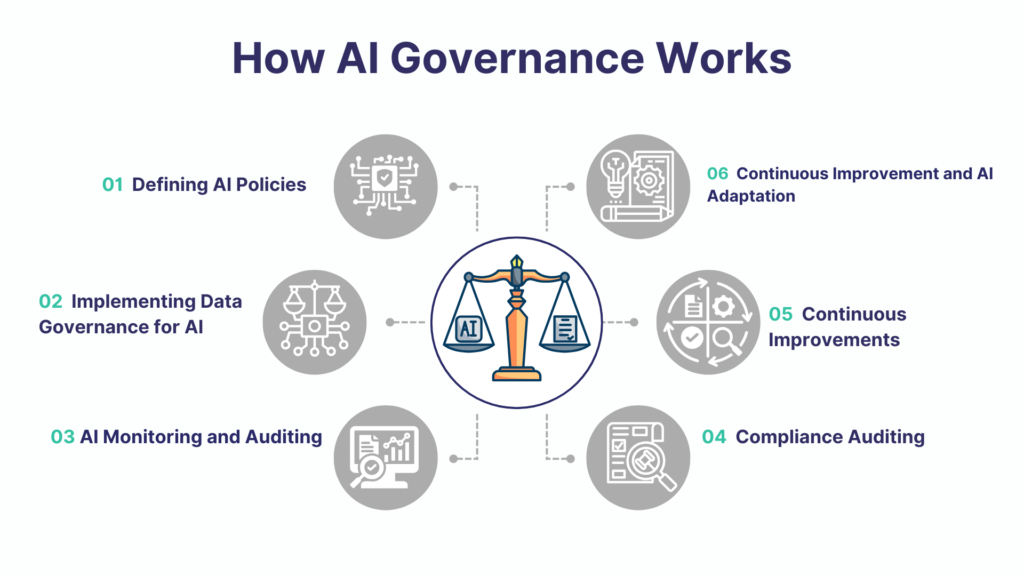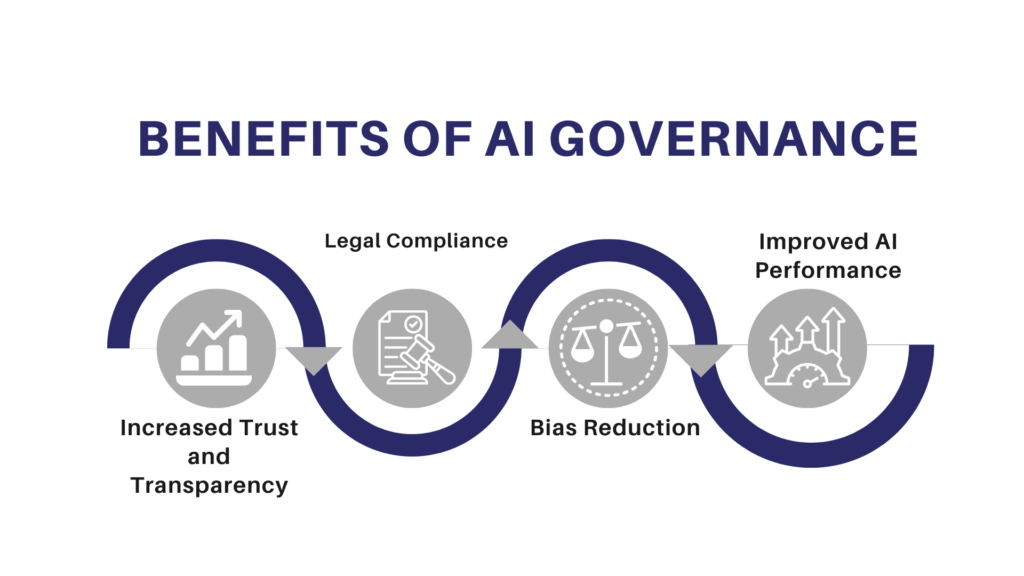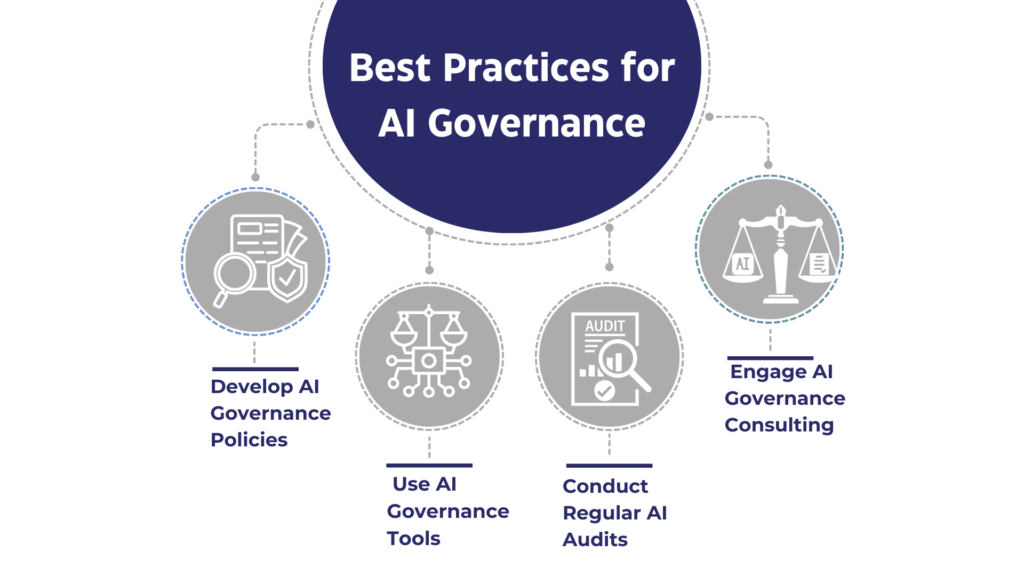Artificial intelligence (AI) is transforming industries, but without proper rules and guidelines, it can lead to serious issues like bias, privacy violations, and ethical concerns. This is where AI governance plays a crucial role.
What is AI Governance?
AI governance refers to the policies, frameworks, and best practices that ensure artificial intelligence is used responsibly. It focuses on making AI systems transparent, ethical, and compliant with laws and regulations.
Many businesses and organizations are using AI for decision-making, customer interactions, and automation. However, without proper governance, AI can cause unintended harm, such as unfair hiring decisions, biased recommendations, or privacy breaches. AI governance ensures that these risks are managed effectively.
In this blog, we will explore how AI governance works, its benefits, challenges, best practices, and governance models that businesses can implement to ensure responsible AI operations.
What Does AI Governance Mean?
AI governance is the system of policies, rules, and tools used to make sure that artificial intelligence is developed and used in an ethical and legal way. It focuses on making AI systems accountable, transparent, and free from harmful bias.
Key Aspects of AI Governance:
- Accountability – Ensuring that organizations take responsibility for AI-driven decisions.
- Transparency – Making AI decision-making processes explainable.
- Fairness – Reducing bias and ensuring non-discriminatory outcomes.
- Privacy Protection – Securing user data and ensuring compliance with data protection laws.
- Compliance – Aligning AI development with legal frameworks and global regulations.
A well-structured AI governance framework helps organizations ensure that AI technologies align with ethical principles and regulatory standards.
Many companies use AI governance tools, such as OneTrust AI Governance, to manage and track AI systems, ensuring they operate fairly and securely.
How AI Governance Works
AI governance follows a structured approach to ensure AI models are used responsibly. Below are the key steps involved:
1. Defining AI Policies
Organizations must set clear rules and guidelines for AI development and use. These policies should address:
- Ethics and fairness
- Security measures
- Data privacy
- Regulatory compliance
2. Implementing Data Governance for AI
Since AI depends on large datasets, businesses must:
- Define how AI collects, processes, and stores data.
- Ensure data is accurate, unbiased, and ethically sourced.
- Follow global data governance AI policies.
3. AI Monitoring and Auditing
Companies must continuously monitor AI models to:
- Track AI decision-making and identify biases.
- Ensure compliance with regulatory standards.
- Use AI governance tools to automate governance processes.
4. Compliance Auditing
Organizations must ensure that their AI systems:
- Follow global AI regulations, such as GDPR, the AI Act, and CCPA.
- Avoid unethical AI practices, such as discriminatory decision-making.
5. Continuous Improvement
Since AI evolves over time, businesses must:
- Update AI models based on audits and new regulations.
- Implement new AI governance best practices as technology advances.
6. Continuous Improvement and AI Adaptation
Since AI evolves rapidly, organizations must:
- Regularly update AI models to meet new regulations and ethical standards.
- Adapt AI governance policies as technology advances.
- Encourage transparency in AI decision-making for long-term trust and accountability.
Key AI Governance Policy Areas
AI governance covers multiple policy areas that businesses must follow to ensure responsible AI practices.
1. Privacy and Security
AI models handle large amounts of sensitive data. Without strict privacy policies, there is a high risk of data leaks and privacy violations. Global regulations such as the General Data Protection Regulation (GDPR) and the California Consumer Privacy Act (CCPA) help protect user data.
2. Fairness and Ethics
AI systems should be free from bias and should not discriminate. An AI-powered hiring tool, for example, should not favor one gender or ethnicity over another. Establishing ethical guidelines ensures fair AI practices.
3. Regulatory Compliance
Organizations must follow AI governance and compliance laws to:
- Prevent unethical AI usage.
- Align AI policies with global regulations, such as the AI Act.
4. Risk Management
Companies must identify AI-related risks, such as:
- Incorrect decision-making
- Security vulnerabilities
- Ethical concerns in AI usage
5. Accountability and Transparency
Organizations should ensure that AI models:
- Provide clear explanations for decisions.
- Are monitored by experts to prevent misuse.
Benefits of AI Governance
AI governance provides several key benefits that improve both business operations and user trust.
1. Increased Trust and Transparency
When AI models are fair and ethical, people trust them more. Transparency ensures that AI is used responsibly, which is crucial for industries like finance, healthcare, and recruitment.
2. Legal Compliance
Many countries are introducing strict AI laws. Organizations that follow AI governance policies can avoid:
- Legal penalties
- Data protection lawsuits
- Regulatory fines
3. Bias Reduction
AI models can develop bias if trained on biased data. Strong data governance AI strategies reduce discrimination in AI-driven decisions.
4. Improved AI Performance
Regular monitoring ensures that AI models:
- Remain accurate
- Operate fairly
- Comply with best practices
AI Governance Models
A governance model defines how AI decision-making is structured in an organization.
1. Centralized Governance Model
- A single authority manages all AI governance.
- Ensures consistency and strict compliance.
- May slow innovation due to bureaucratic approval processes.
2. Decentralized Governance Model
- Different teams manage AI policies.
- Provides flexibility for innovation.
- Requires strong coordination to maintain consistency.
3. Hybrid Governance Model
- Combines centralized and decentralized approaches.
- Balances compliance and innovation effectively.
Challenges in AI Governance
Even with strong AI governance frameworks, organizations face several challenges:
1. Lack of Standardized Regulations
Different countries have different AI governance laws, making it difficult for global businesses to follow a unified standard.
2. Balancing Compliance and Innovation
Strict AI regulations prevent misuse but can also slow down technological progress.
3. Ensuring High-Quality Data Governance for AI
AI models require large, unbiased datasets. Poor data quality can lead to inaccurate AI decisions.
4. Transparency Issues
Some AI models function as “black boxes”, meaning their decision-making process is unclear. Businesses must work towards making AI more explainable.
Best Practices for AI Governance
1. Develop AI Governance Policies
Set clear rules for AI compliance, ethics, and risk management.
2. Use AI Governance Tools
Solutions like OneTrust AI Governance help automate compliance tracking.
3. Conduct Regular AI Audits
Regular audits ensure AI remains fair and unbiased.
4. Engage AI Governance Consulting
AI experts can help refine governance frameworks and compliance strategies.
Conclusion
AI governance is essential for ensuring fairness, compliance, and accountability in AI systems. Businesses must adopt AI governance frameworks, follow best practices, and use AI governance tools to manage risks effectively.
By implementing clear policies, strong data governance, and expert consulting, organizations can develop AI systems that are ethical, transparent, and legally compliant.
The future of AI depends on responsible governance, let’s build it the right way!
FAQs
1. What is AI governance, and why is it important?
AI governance refers to the rules, policies, and frameworks that ensure AI systems operate ethically, transparently, and in compliance with regulations. It is important because it helps prevent bias, security risks, and unethical AI practices, ensuring that AI benefits society while minimizing harm.
2. What are the key principles of AI governance?
- The key principles of AI governance include:
- Transparency – Ensuring AI decisions are explainable.
- Fairness – Preventing biases and discrimination.
- Accountability – Defining responsibility for AI actions.
- Privacy and Security – Protecting user data.
- Compliance – Following AI laws and regulations like GDPR and the AI Act.
3. How does AI governance impact businesses?
- AI governance helps businesses:
- Build trust with customers and stakeholders.
- Ensure regulatory compliance to avoid legal penalties.
- Improve AI performance by reducing errors and biases.
- Manage risks related to data privacy and security.
4. What are AI governance tools, and how do they help?
AI governance tools, such as OneTrust AI Governance, help organizations track, audit, and monitor AI models to ensure compliance with ethical standards and legal regulations. These tools provide insights into AI decision-making, bias detection, and data protection.
5. What are the biggest challenges in AI governance?
- Some of the main challenges include:
- Lack of standardized global regulations for AI.
- Balancing innovation and compliance without slowing down progress.
- Managing bias in AI models to ensure fair decision-making.
- Ensuring data security and privacy in AI-driven systems.
6. How can companies implement effective AI governance?
Companies can implement AI governance by:
- Developing clear AI policies that align with ethical and legal standards.
- Using AI governance tools to automate compliance tracking.
- Conducting regular AI audits to monitor AI behavior.
- Training employees on AI ethics and responsible AI practices.










